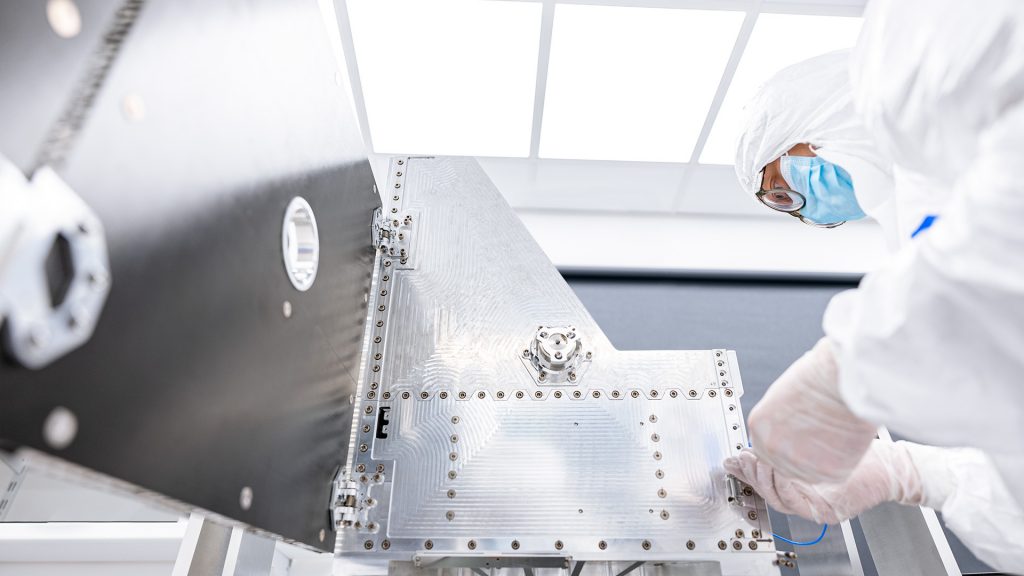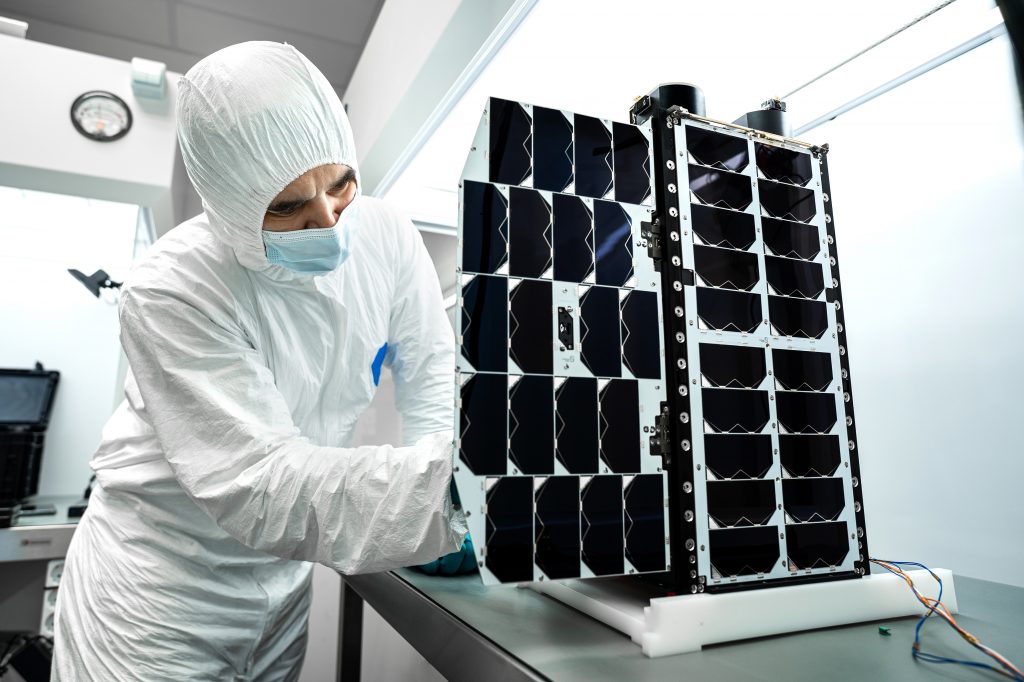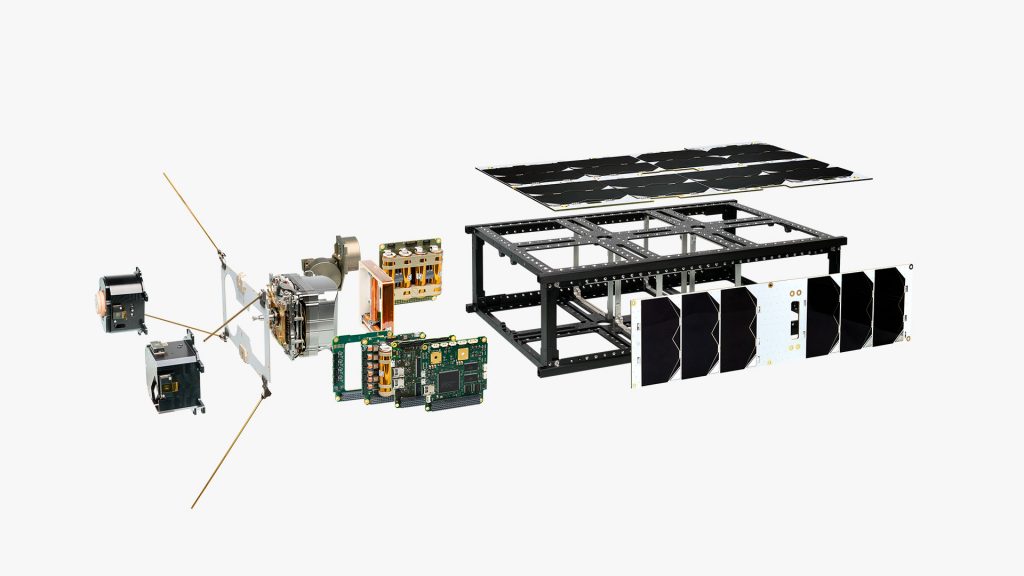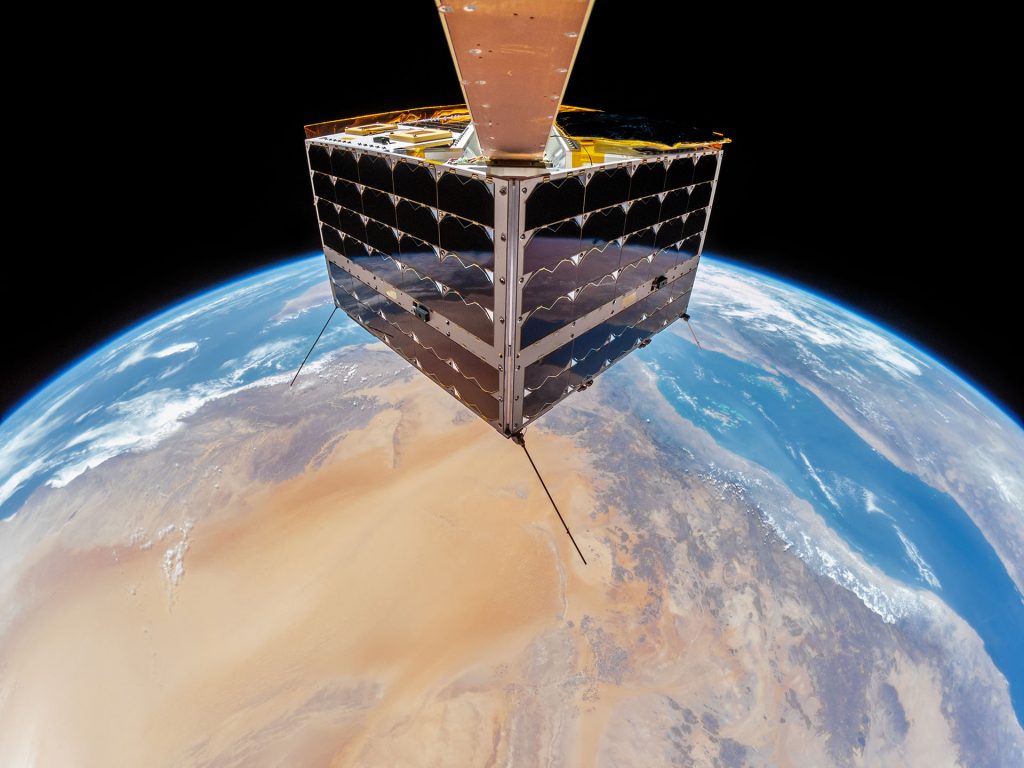- 2023-04-26
The miniaturization of space technology is an ongoing trend, but mission requirements should drive the choice of satellite size. This article examines essential factors to determine the ideal platform size for a CubeSat or small satellite mission constellation.
The primary payload

NanoAvionics “MP42” satellite assembly.
There’s a common misconception about payload size being the primary driver of a platform’s volume. For example, a new Earth Observation (EO) company developing their first system based on an imager of 12U size may expect to easily fit it into a 16U CubeSat envelope. However, an effective small satellite requires more than just the primary payload. Power and thermal management equipment, solar cells/panels, batteries, attitude control, downlinking, onboard computers, and processing systems all contribute to achieving mission objectives and require additional mass and volume.

Kongsberg NanoAvionics engineer testing a 16U nanosatellite.
Onboard data processing (OBDP) and artificial intelligence (AI) have brought new capabilities to small satellite mission operators. However, higher processing capabilities often require more power, greater satcom capacity, and additional thermal management. These factors can increase the amount of hardware needed for small satellites.
Performance over hardware
Mission designers should conduct assessments based on the required performance levels to avoid biasing system selection by focusing solely on the primary payload. Supporting systems for CubeSats are classified into:
- Power requirements – solar cells and panels, batteries, Electrical Power System (EPS), thermal control, and connecting and management hardware.
- Positioning, pointing accuracy, and agility – Attitude Determination and Control System (ADCS), reaction wheels, magnetorquers, propulsion, sensors, and interfaces.
- Processing and data storage – Onboard Computer (OBC), payload processors and OBDP systems, Command and Data Handling (C&DH) system, memory, data interfaces, and control software and hardware.
- Downlinking and communication – antennas, radios, communication systems, and associated hardware.
- Subsystem redundancy and/or extra power budget margins.

M6P-nanosatellite-subsystems.
Considering hardware trade-offs when planning a volume budget for a CubeSat or other small satellite is crucial. For example, larger subsystems may require more power but usually have better thermal management than smaller equipment.
In small satellites designed for communications, higher-power radios can be notably bulky, and the primary antenna can play a significant factor in choosing a small satellite platform size. Despite needing less power, lower radio frequency antennas need to be larger for precise signals – primarily if a deployable system is used.
Engineering considerations
Engineering considerations play a crucial role in small satellite platform size choices. A larger platform doesn’t necessarily mean a more complex system, and it’s often easier for engineers to work with larger CubeSats and small satellites, as they can be manipulated, constructed, and tested faster and with fewer resources. Larger small satellite systems also offer more flexibility and room for sophisticated design requirements.

A smaller satellite can be more challenging to assemble due to volume limitations.
For instance, a high-resolution imaging payload would have little space on a 16U CubeSat platform for larger reaction wheels, limiting the nanosatellite’s maneuvering abilities. In comparison, a NanoAvionics MP42H microsatellite bus with larger reaction wheels would have a higher slew rate and image more targets during the same orbit. The MP42H could also include larger solar panels, drastically improving the payload’s duty cycle. These improvements could deliver multiple times more imaging opportunities during every orbit, leading to increased revenue. The price increase from an M16P to an MP42H can be insignificant, so there is greater potential for a higher return on investment.
Furthermore, engineers evaluating 6U CubeSat options should consider the 8U a highly feasible alternative. The NanoAvionics 8U nanosatellite (M8P) bus can deliver nearly the same orbit average power (OAP) as a 16U CubeSat while enhancing mission capabilities and redundancy with only a slight increase in production and launch costs compared to the M6P.

Kongsberg NanoAvionics’ M8P offers similar OAP to a 16U nanosatellite bus
Read more about small satellites design on NASA’s State-of-the-Art of Small Spacecraft Technology.
Mission Plan
The mission plan, defined by performance levels specified in the business plan, dictates small satellite platform size selection. Factors like delta-v requirements, single satellite or constellation, service level, accessibility, and space sustainability policies are vital in determining platform size for small satellites and CubeSats. Propulsion systems enabling end-of-life deorbiting maneuvers should be evaluated, as they might necessitate platform scaling. The mission plan, along with contingencies, determines small satellite hardware and software choices.
Costs and Budgeting for CubeSats and Small Satellites
Despite decreasing costs of building, launching, and operating CubeSats and small satellites, the budget is crucial when selecting a satellite platform size. Considerations for small satellite missions include:
- Engineering time and resources.
- Launch and deployment options – availability and delays.
- Return on Investment (RoI) – larger CubeSats and small satellites can provide higher volumes of valuable data.
- Ongoing operations – ground station subscriptions, licensing renewals, data handling, storage, security costs, staffing, etc.
- Single vs. multi-satellite missions – economies of scale may reduce the overall mission budget, enabling investment in larger, better-performing CubeSat and small satellite platforms.
- Risk appetite – weighing risks in financial decisions.

The price increase from an M16P to an MP42H can be insignificant, so there is greater potential for a higher return on investment.
A holistic approach to CubeSat and small satellite mission design, considering RoI alongside initial and ongoing outlay, can help make development decisions easier for nanosatellite projects.
CubeSat and Small Satellite: What Not to Consider
When designing a CubeSat or small satellite mission, some factors have minimal impact on platform size selection. These factors are essential for assessing costs and resources but should be considered independently from platform size. Three key factors with minor influence on CubeSat and small satellite platform size selection include:
- Ground segment: Innovations in the ground segment offer new opportunities for CubeSat and small satellite mission designers. Managed networks provide flexible and affordable business models, new communication systems deliver higher bandwidths at lower costs, and software platforms simplify engagement with ground stations.
- Logistics requirements: While larger systems might slightly increase transportation costs, logistics costs have little bearing on CubeSat and small satellite platform size selection. The rapidly developing space industry supply chain provides various options for moving hardware between manufacturing locations, testing facilities, and launch sites.
- Licensing and compliance: Although satellite licenses are crucial, most compliance aspects are related to a CubeSat or small satellite’s intended applications and use rather than its dimensions.
Selecting the right CubeSat or small satellite platform is vital, as dimensions dictate the variety and quality of subsystems onboard, the satellite’s potential applications, and the commercial value it can generate. For further advice on the best-suited platform, contact us at info@nanoavionics.com for a mission questionnaire and discussion on your requirements.






